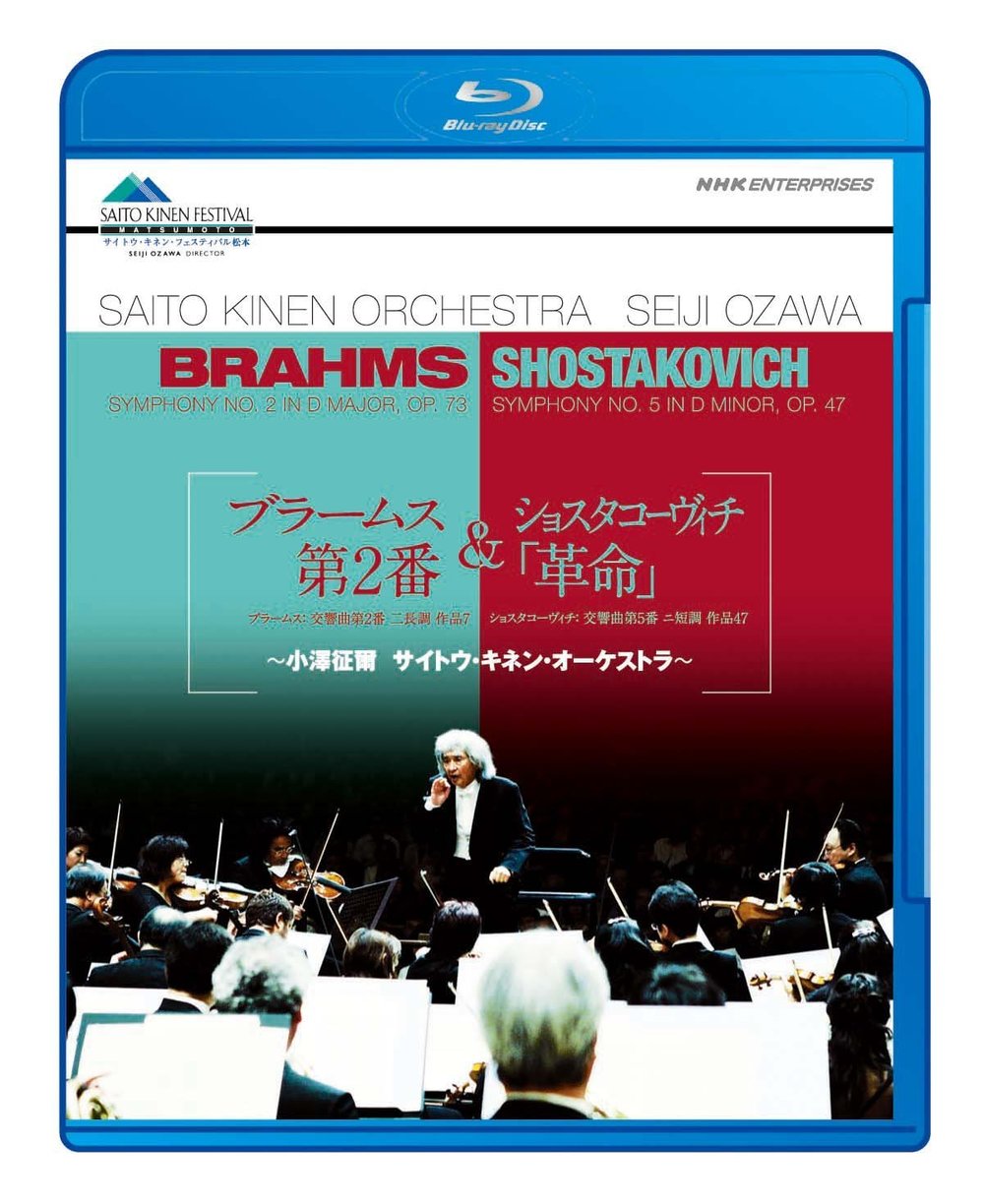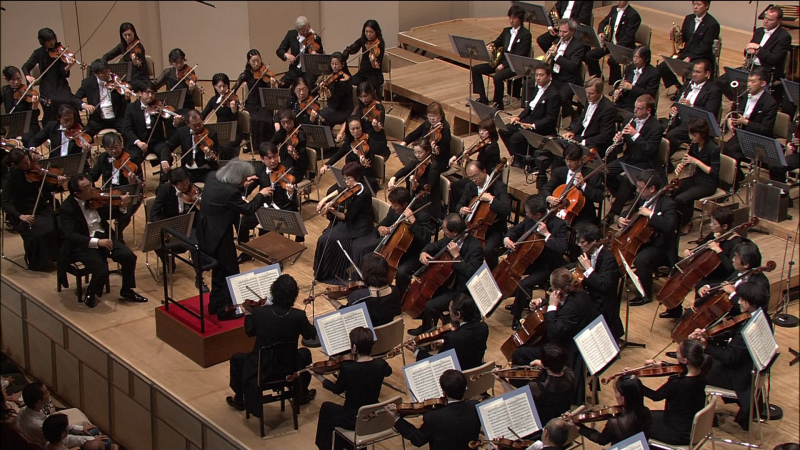Brahms 💓 Symphony No. 2 and Shostakovich Symphony No. 5. Seiji Ozawa conducts the Saito Kinen Orchestra. Released 2010, disc has 5.0 PCM sound for both symphonies and valuable bonus features. It is also one of the titles in the Seiji Ozawa 75th Anniversary Box Set. Grade: for Brahms A+; for Shostakovich B-
The Saito Kinen recording of Brahms Symphony No. 2 was made in 2009, and it was released in 2010. The NHK folks were trying hard; and with this title, they moved up to a new level of excellence in the recording of symphony music. Seeing this was the first time in my life when I felt I had supped with Brahms, a composer I usually listened to from a sense of duty rather than desire. This is one of the best played and recorded symphony performances I have experienced.
Why is this recording so good? The Saito Kinen group was fired up (you see that best after the performance). The NHK engineers had perfected their 96kHz/24 bit sound recording techniques in the large venue, and the SQ is unexcelled. You can hear all the instruments all the time in isolation and combined in gorgeous sound-fields. In particular, you can hear wonderful renditions of string pizzicato playing in the background when the winds take the lead with the melodies. The PQ of the video is also unbelievable realistic and pretty. The cameramen were supported with plentiful lighting of the stage. Every shot is well framed and possesses complete and perfect focus throughout the whole depth of the stage. Absolutely no videography monkey business is allowed such as repetitive shots of players who happen to be sitting in front of cameras. Finally, the picture content was expertly planned and recorded as described in our standards for HDVDs of symphonic concerts.
The Shostakovich Symphony No. 5 was recorded three years earlier in 2006 with a huge orchestra. (Probably only about 25% of the players in 2006 were also in the orchestra in 2009.) The musical performance is intimate, nuanced, mysterious, and spiritual. Due at least in part to the 96kHz/24 bit sound recording techniques used, the sound is clean and accurate.
The raw PQ is also fine. But, alas, this video suffers from a distinct case of DVDitis. There is way too much emphasis on the conductor and there are many of the dreary rear shots which show the conductor over the backs of 30 to 45 musicians. There are only a few whole orchestra shots and almost no shots of whole sections or groups of sections. For example, the video never shows you the five horns as a group. Instead, we see too many small portions of sections. There is too much senseless panning within sections and zooming in and out just to be doing something. Many times we see weakly framed shots such as an instrument without its player or the concert master from behind. There are too many focus issues and shots that suffer from inadequate depth of field of focus. So this recording violates most of our standards for HDVDs of symphonic concerts.
It appears that in 2006, not even the experts at NHK understood that HDVD shows of the symphony have to be photographed differently from DVDs. But by 2009 (when the Brahms Symphony No. 2 was recorded) the NHK folks had figured this out.
Now let's enjoy a few screen shots from the Brahms Symphony No. 2.
Here's a full-orchestra shot which fills the entire field of view. This is workable with 1080 lines of video resolution. But you can see that more resolution would be welcome at this range with this many players on the stage. Maybe one day we will have "4K" recordings that will allow you to see this image with the same resolution you get with your own eyes in the typical concert hall:
Below is my favorite whole-orchestra shot for this event. Here you can see every player and you can see most of them well because the camera is closer. But something has to give. The 1st violins are seen from behind; the 2nd violins must serve as proxy. But note also: this is one of the few views that lets you see all the violas. There are 10 violas in two rows next to the stage, but then there are 2 more in front of the double-basses:
Here the view looking looking across the orchestra from the other side of the stage. This is the best shot on the disc of the violins. If I had any constructive criticism of this disc, I would ask for at least one shot with every violin (1st and 2nd):
I'm not going to show any solo or 2 person sections. Instead I'll try give you a few good shots of multiple sections (which are rarely seen in DVDs). Here are trombones, clarinets, bassoons, and flutes:
Here's all the brass but the tuba:
The tympani and bones again:
Finally, here's a good utility shot of the cellos. This can also be used with everybody is playing and you want to be closer than a full-orchestra shot:
The shots above are just a few example—almost every view is just as pretty.
Now see the Worksheet I did on this Brahms Symphony No. 2. The most important thing to note is that there are 23 whole-orchestra shots, 24 part-orchestra shots, and 53 large scale views! This totals 100 "supershots." There are 256 cuts in the video, so 39% of the clips are supershots! The 256 clips comprise 45:30 of music, for a stately pace that averages close to 11 seconds per cut. This is half the pace, or twice as slow, as a typical DVD. There are only 33 conductor shots for 13% of total clips. And this disc does have nice shots all your favorite principal players in solos. It does not have worthless shots of players' backs or of instruments only. There is some zooming and panning, but always done slowly and tastefully with no motion artifacts.
Tellingly, this video was not offered in DVD. It was shot to show how good a symphony can sound and look in HD TV, i.e. it's a true HDVD product. You can't make a video that works well in both DVD and HDVD presentations. The two formats are mutually incompatible.
In summary: for superb playing, sound recording, video quality and video content, I give this Brahms Symphony No. 2 an A+ and our 💓 designation for work of special quality and importance. Because of DVDitis, I would give the Shostakovich Symphony No. 5 a C. But thanks to its superior 96kHz/24 bit sound, I move the grade for Symphony No. 5 up to B-.
Want to see the difference between an A+ symphony recording and one of the same piece that's graded F? just compare the story above on the Saito Kinen recording of the Brahms Symphony No. 2 to our story about the Brahms S2 by the Lucern Festival Orchestral published by Accentus.







